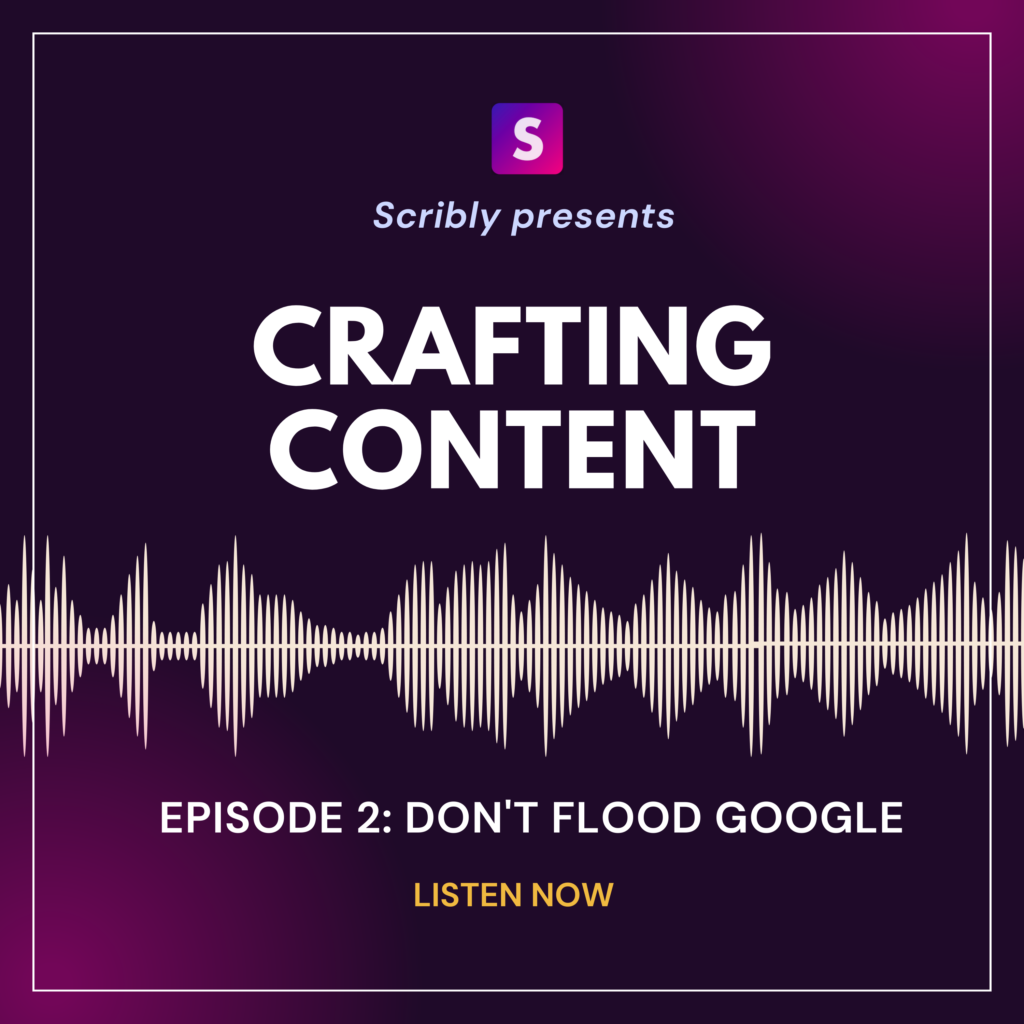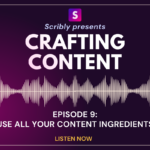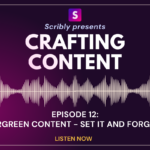Crafting Content – A content marketing podcast from Scribly
Crafting Content episode 2: Don’t flood Google
Ready to listen to the second episode of Scribly’s “Crafting Content” podcast? This content marketing podcast has been created with the intention of sharing Scribly and our team’s vast amount of content marketing knowledge. Every episode will include insights, top tips, and real-world examples to help you develop your content marketing skills.
Continuing on our “common content marketing mistakes” mini-series, today’s topic is about creating high-quality content that readers want to enjoy. We discuss the importance of wordcount, structure, readability, SEO-optimization, and more to help you better understand what makes high-quality content high quality, and how to optimize poor-quality content.

You can listen to the full episode here: Scribly’s Crafting Content Podcast Episode 2 – Don’t flood Google
Episode 2: Don’t flood Google (transcript)
Taylor: Hello and welcome back to Crafting Content, the Scribly Podcast. We are in the middle of a series of episodes about the most common content marketing mistakes that we see. We’ve already covered not focusing on all of the different stages of the marketing funnel and customer journey.
Today, we are going to tackle another common mistake that we see. Joining me today is Elle. What do we think is another mistake that companies are making?
Elle: Hey, Taylor. Thanks for having me back.
One of the mistakes that you and I chat about quite a lot—particularly when we get new customers that come in, ask us to review their existing content and explain why they’re struggling to get the engagement and the results they want from their content marketing effort—is not focusing on high-quality content.
There’s a little bit of a myth or a belief that people have that the more content they put out there, the more traffic they’ll attract. But, as you and I know, putting a lot of very short blocks of text out there will never get the results that a business hopes for because no one will enjoy reading or interacting with that content. Instead, it’s actually going to have a negative impact on your brand as opposed to the positive impact you want to see.
I know that recently you’ve worked in a couple of cases where you’ve seen mass content creation often. So I’m sure you’ve got some insights to share on this one.
Taylor: I think that it’s a really interesting problem, right? Because in the early days of the Internet, that’s what you were supposed to do. You were supposed to put out as much content as possible. It didn’t really matter if it was a certain length or a certain format. It was just about flooding Google with everything you possibly have. But that doesn’t work anymore, because everyone else did that for years as well. So, there’s already a massive amount of information out there on the internet, and if your content doesn’t stand out, and doesn’t appropriately answer your users’ queries and questions, then it’s not going to stand out.
It’s not going to get promoted up through the ranks of search engines. So, I think that yes, brands can create content that says the same thing that their competitors are saying, but it’s much more valuable to people. Even if you’re talking about a similar topic, you can offer a unique point of view or a unique element to your content.
Elle: Let’s say someone comes to you, they’ve got an article and they want to know why this isn’t performing very well. What are the top things that you’d look for in terms of identifying why it’s low quality and what would you do to flip it and make it high quality?
Taylor: Well, the first thing I would look at is a word count and structure because they work together. If you have a 500-word post with three, four, or five subheadings, that probably means that you’re dedicating 100 words or less to different subsections of this topic. What that means to me is nine times out of 10, you’re not going to be able to get in-depth enough into any one of those aspects of this topic to provide useful information to a reader.
So that’s the first thing I’d look for. Generally, no less than 1000 words is a rule of thumb for a blog post—give or take depending on the company and their goals. You want enough space to be able to talk about what you’re talking about. You need to have some preamble and guide readers into the topic, then explain what it is, how it works, and the context, and then have enough breathing room to really talk about things.
That’s what I would look at. If something was too short, I’d say that we don’t have enough space here to really get into enough detail. Generally, there are two ways to fix that. Either write a longer post or cover less things in a shorter post.
Elle: A common thing we often see is people trying to do too much with too small a space.
Ideally, you might recommend breaking a topic down into multiple blog posts or having a much longer in-depth guide and then lots of shorter blogs that can go into a bit more detail.
It comes down to crafting longer, better-structured content, but also having those silos of content to have the space to really deep dive into each point.
The other consideration we often share with customers is the importance of quality content from an SEO perspective. I know I’ve heard you lecture a few of our writers about the importance of following a coherent structure and the keyword research provided.
There’s a lot of education that happens both from a client and an internal perspective in terms of how we effectively choose and include keywords within our copy to ensure that we’re reaching that SEO-quality content.
I hate using the term “checklist” because it’s obviously a lot more complicated than that, but so much of what you do when you come to editing content and quality-checking content is about doing an SEO assessment.
Taylor: That can be a really hard one for people to wrap their heads around. Even when I was first learning about SEO and keywords, it was confusing. There are certain best practices that you need to follow and those best practices can change based on Google’s algorithms and trends.
In SEO, people sometimes just latch on to one thing, when in reality, it’s a very big, complex, hairy thing to wrap your head around. They latch on to one thing and they say: “This post has great internal links. So, that’s all I need and why isn’t it performing better?”. Or, “This post has a keyword in it. It should be performing better.”
When, to have high-quality content that performs well, you need to include multiple aspects of SEO best practices. You need to have your keywords, links, and a structure that makes sense, and make sure that it’s readable and easy to read.
Nobody wants to read a single-spaced block of text that’s 1000 words long. It’s intimidating and I don’t want to see that on my computer or phone screen. Studies show that that’s not how people read on the internet. They read in like an f shaped pattern, right?
Our brains scan and scroll and pick out the important bits. So, if your content isn’t structured to guide people’s eyes towards where the important bits are, then it’s not going to do what you want it to do.
Elle: That skip reading element of reading online is so important because, if you don’t have those guiding points, then 1) people can’t really understand what it is that each section of your content is talking about, and 2) people tend to read through content because they’re looking for something specific. So, if you’ve got headers which are optimized based on the key questions a customer might have, then you’re expecting a reader to only read a section that is related to their query. So, they’re going to scroll through, look for the section that they’re interested in, and engage with that page.
Whereas if you don’t have those headers that make it easy for them to find the information they’re looking for, then they might just bounce off and not engage with the page.
Taylor: I’ve done that. Control F to find the specific phrase that I’m looking for. And if it’s not there, I’m going somewhere else.
Elle: What we’re getting to is that the quality content has everything to do with: “Are you providing quality to the end user?” Because at the end of the day, if they’re not enjoying reading it, if there’s not enough information on the page to answer their questions and to meet their needs, then there’s no point even having that content.
Taylor: There’s something to be said as well for creating content for search rankings—which is how a lot of companies approach content marketing—but at the end of the day, you need to be creating content that, yes, is optimized for search, but is ultimately for people because they’re the ones doing the searching.
Elle: That’s the number one rule we always remind our writers of when we craft content for any of our clients. Scribly writes for people.
Taylor: So that’s a big one and hopefully this little discussion about it helps illuminate what is and isn’t high-quality content in the world of content marketing.
In the next episode, we are going to talk about something that I sort of jumped the gun on a little bit: SEO best practices. So, stay tuned for that and we will see you there.
Thank you for listening to Crafting Content, a content marketing podcast from Scribly. You can find more information about what we cover today in our show notes. Scribly is a content marketing agency that helps you boost traffic, generate sales, and increase your bottom line. With our end-to-end service, we take care of everything from content audits and strategy to content creation and management across websites, blogs, socials, and email.
We’re a small but mighty team of experienced strategists and marketers who specialize in content creation. If you want to learn more about how Scribly can help your business, please get in touch. You can find more information and send us a message on our website. We’d love to hear from you.




